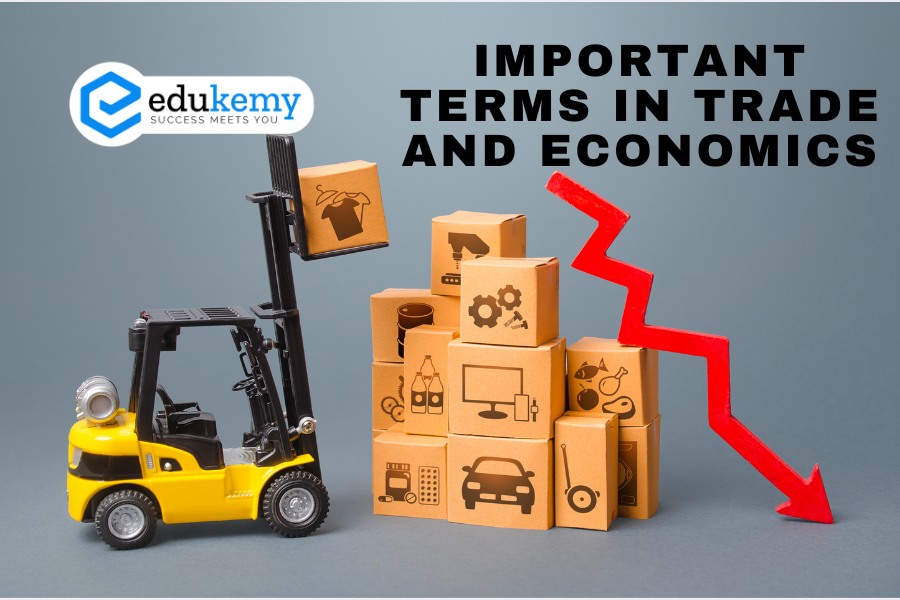
The world of trade and economics can seem like a complex web of terms and concepts. This guide will introduce you to essential terms that unlock the inner workings of international trade, helping you grasp how countries exchange goods and services, and how these interactions impact economies around the world.
Contents
Important Terms in Trade and Economics:
- ACP Countries:
- Definition: About 70 African, Caribbean, and Pacific (developing) countries that have preferential access to the EU market.
- AMS (Aggregate Measure of Support):
- Definition: AMS shows the extent of support provided by governments to the agricultural sector, including measures like minimum support prices (MSP) in India. There are limits set on AMS under the Agreement on Agriculture (AOA) of WTO.
- Beggar-thy-Neighbour:
- Definition: A policy where one nation seeks to solve its economic problems at the expense of others. It involves actions that harm other economies. For example, China’s devaluation of the renminbi and dumping practices are seen as beggar-thy-neighbour policies.
- Cairns Group:
- Definition: A coalition of 19 agricultural exporting countries. Its members aim to abolish trade-distorting amber box domestic support for agricultural products and seek improved market access for agricultural exports.
- Non-Agricultural Market Access (NAMA):
- Definition: NAMA relates to trade negotiations on non-agricultural or industrial products. It involves discussions on reducing or eliminating customs tariffs and non-tariff barriers on trade in industrial products. Nama 11 is a coalition of strong developing countries, including India.
- Natural Persons:
- Definition: Individuals, as distinct from juridical persons such as companies and organizations. Movement of natural persons concerns the ease of travel and the ability to live and work in other countries.
- Non-Tariff Barriers:
- Definition: Government measures, other than tariffs, that restrict trade flows. Examples include quantitative restrictions, import licensing, standards, and conformance regulations.
- Tariff Escalation:
- Definition: Tariff rates that increase with each additional level of processing, penalizing value-added products.
- Tariff Peaks:
- Definition: Relatively high tariffs, usually on ‘sensitive’ products, amidst generally low tariff levels. Tariff peaks for industrialized countries are generally tariffs of 15 per cent and above.
- Tariff Rate Quotas:
- Definition: Tariff rate quotas allow a certain volume of product access at a lower tariff level. A higher tariff is charged on products imported outside the tariff quota.
FAQs
- What are Terms of Trade (TOT)?
The Terms of Trade (TOT) measure a country’s relative trading power. It compares the price of a country’s exports to the price of its imports. A higher TOT indicates a country is getting more for its exports compared to what it pays for imports. This is generally seen as beneficial. You can calculate a country’s TOT by dividing its export price index by its import price index and multiplying by 100.
- What are Free Trade Agreements (FTAs)?
Free Trade Agreements are deals between countries or economic zones to reduce barriers to trade. This can include eliminating tariffs (taxes on imports) and quotas (limits on import quantities). FTAs aim to boost trade between the signing parties, benefiting businesses and consumers through access to wider markets and potentially lower prices.
- What is the difference between Comparative Advantage and Absolute Advantage?
Comparative advantage refers to a country’s ability to produce a good or service at a relatively lower opportunity cost compared to another country. Even if a country isn’t the absolute best producer of something, it can still benefit from trade if it has a comparative advantage. Absolute advantage describes a situation where one country can produce a good or service more efficiently (using fewer resources) than any other country.
- What is a Balance of Trade (BOT)?
The Balance of Trade refers to the net difference between a country’s exports and imports over a specific period. A positive BOT (trade surplus) indicates a country is exporting more than it imports. Conversely, a negative BOT (trade deficit) means a country is importing more than it exports. While a trade surplus might seem ideal, it’s not always the case. A healthy and sustainable trade balance depends on various factors specific to each country’s economic situation.
- What is Globalization?
Globalization refers to the increasing interconnectedness between countries and economies worldwide. This is driven by factors like advancements in communication technology, transportation, and trade liberalization. Globalization has significant economic, social, and political implications. It can create opportunities for growth and efficiency but also raise concerns about job displacement and income inequality.
In case you still have your doubts, contact us on 9811333901.
For UPSC Prelims Resources, Click here
For Daily Updates and Study Material:
Join our Telegram Channel – Edukemy for IAS
- 1. Learn through Videos – here
- 2. Be Exam Ready by Practicing Daily MCQs – here
- 3. Daily Newsletter – Get all your Current Affairs Covered – here
- 4. Mains Answer Writing Practice – here

